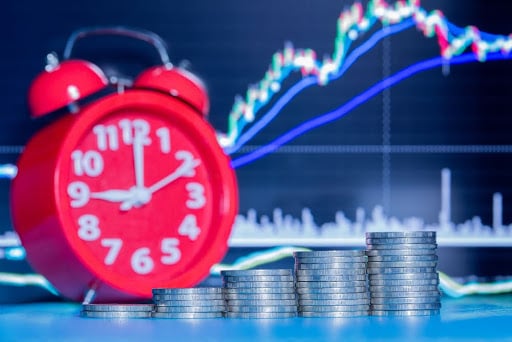The Best Chart Time Frames for Crypto Day Trading vs. Swing Trading


Cryptocurrency trading is lively, and the chart time frame employed can be the key to success or failure of a strategy. Most beginners , but the time frame you glance at prices significantly influence your decision-making. Whether you are a crypto day trader in search of quick price changes or a swing trader looking for mid-term trends, your chart configuration needs to be aligned with your strategy.
This article analyzes the best chart time frames for swing trading and day trading of cryptocurrency, why traders employ these , and outlines tips on how to select the best ones.
Key Takeaways
- The best chart time frame depends on your trading style—shorter frames suit quick-paced day trading, while longer frames align with swing trading.
- Using multiple time frames together strengthens decision-making by confirming entries and avoiding false signals.
- Consistency matters most: stick with time frames that match your strategy and lifestyle, adjusting only when necessary.
Understanding Chart Time Frames
A chart time frame covers the length of market activity captured by each bar (or candlestick) on a .
For instance, on a 1-minute chart, each candlestick shows the open, high, low, and close prices within a single minute of trading, providing highly detailed price action. However, on a 1-hour chart, each candlestick summarizes an entire hour of market movement, while on a 1-day chart, each candlestick represents the full trading activity of a day.
Multiple time frames highlight diverse patterns. Shorter charts reveal small price movements, while longer charts indicate broader trends. Choosing the right one depends on your trading style.
Types of Crypto Trading Styles
Trading styles differ based on the timeframe for which the traders hold positions.
- Scalpers
-
- Timeframe: Seconds to minutes.
- Objective: Smaller profits from minute price fluctuations.
- Attributes: quick decisions and allow several trades a day based on speed and liquidity.
- Day Traders
-
- Timeframe: For just a day (minutes to hours).
- Objective: Profit from intraday market changes, no overnight positions.
- Attributes: Less screen time, excellent risk management, and intraday concentration.
- Swing Traders
-
- Timeframe: Days to weeks
- Objective: Catch medium-term price “swings”
- Attributes: Less screen time than day traders, use technical and fundamental analysis.
- Position Traders
-
- Timeframe: Weeks to months (sometimes years).
- Objective: Ride large trends over the long term.
- Attributes: Patience, long-term focus, rely more on fundamentals than on short-term price charts.
- Investors (purchase and Hold)
-
- Timeframe: Years
- Objective: Build wealth over time through sustainable growth.
- Attributes: Focus on the basics, less interested in intraday or intraweek price movement.
Crypto Day Trading
Crypto day trading is open and closed within the identical day. Here, traders need to act quick. They employ short time frames to spot quick opportunities while keeping an eye on slightly larger charts for confirmation. There is no overnight risk involved.
Top Chart Time Frames for Day Traders
- 1-minute to 5-minute charts: Best for scalpers who want to catch tiny price moves and trade frequently.
- 15-minute chart: Offers balance between speed and clarity, assisting to reduce market “noise.”
- 1-hour chart: Used as a reference for identifying intraday trends and stronger support/resistance levels.
Benefits
- Traders can earn money within hours or minutes if trades go your way.
- Close trades before the market closes, avoiding gaps as a result of news/events.
- High market engagement: Frequent trades assist with developing skills in chart reading, patterns, and market psychology.
Dawbacks
- Requires constant watching of charts and quick decision-making.
- Frequent purchaseing/tradeing often increases broker commissions and fees.
- Even small mistakes can lead to large losses rapidly due to .
Crypto Swing Trading
This works by cutting through intraday noise, offering clearer technical signals, and matching the rhythm of multi-day holding periods.
Swing traders do not need to watch the market every second. They focus on largeger moves that play out over several days or weeks.
Top Chart Time Frames for Swing Traders
- 4-hour chart: This is the shortest timeframe in swing trading. Popular among traders as it captures medium-term moves clahead and can inform exit/entry decisions.
- Daily chart: Essential for identifying major trends, strong support/resistance, and market sentiment, particularly for those that occur overnight.
- Weekly chart: assists confirm long-term patterns and avoid trading against the largeger trend.
Benefits
- No need to monitor the market during the day; checking a few times a day may be enough.
- Positions are maintained for days to weeks, allowing traders to profit from largeger moves in price.
- Fewer trades mean fewer fees compared to day trading.
Drawbacks
- Market gaps exposure caused by news, earnings, or geopolitical events.
- Trades may take days or weeks to develop, testing discipline.
- Longer holding periods decrease the ability to take advantage of new opportunities.
| Trading Style | Best Primary Time Frames | Supporting Time Frames | Key Benefits |
| Day Trading | 1-min, 5-min, 15-min | 1-hour | Quick entries and exits capture short-term volatility |
| Swing Trading | 4-hour, 1-day | Weekly | Clearer trends, reduced noise, fits multi-day holding strategy |
4 Tips for Choosing the Best Time Frame
- Match your lifestyle: If you can’t watch charts all day, swing trading time frames will suit you better.
- Use multiple time frames: Always confirm a setup on a higher time frame before entering a trade.
- Stick to your plan: Avoid switching time frames out of impatience or fear.
- Adapt to market volatility: In highly volatile markets, shorter charts may show false signals. Rely more on higher time frames.
Bottom Line
There is no single “perfect” chart time frame for crypto trading. You can decide to utilize short-term strategy through day trade or swing trade as the market demands to maximize as much profit as possible. Day traders adore the 1-minute to 15-minute charts with hourly confirmation, whereas swing traders employ 4-hour, daily, and weekly charts for overall trends.
Consistency is the trick. Choose time frames that support your strategy, test with them, and change only when necessary. If you want to capture smaller intraday swings or ride largeger waves, using the right chart time frame will allow you to trade smarter and more confidently.







